Neuschwanstein Castle: the Mysterious History of Germany’s Most Popular Castle
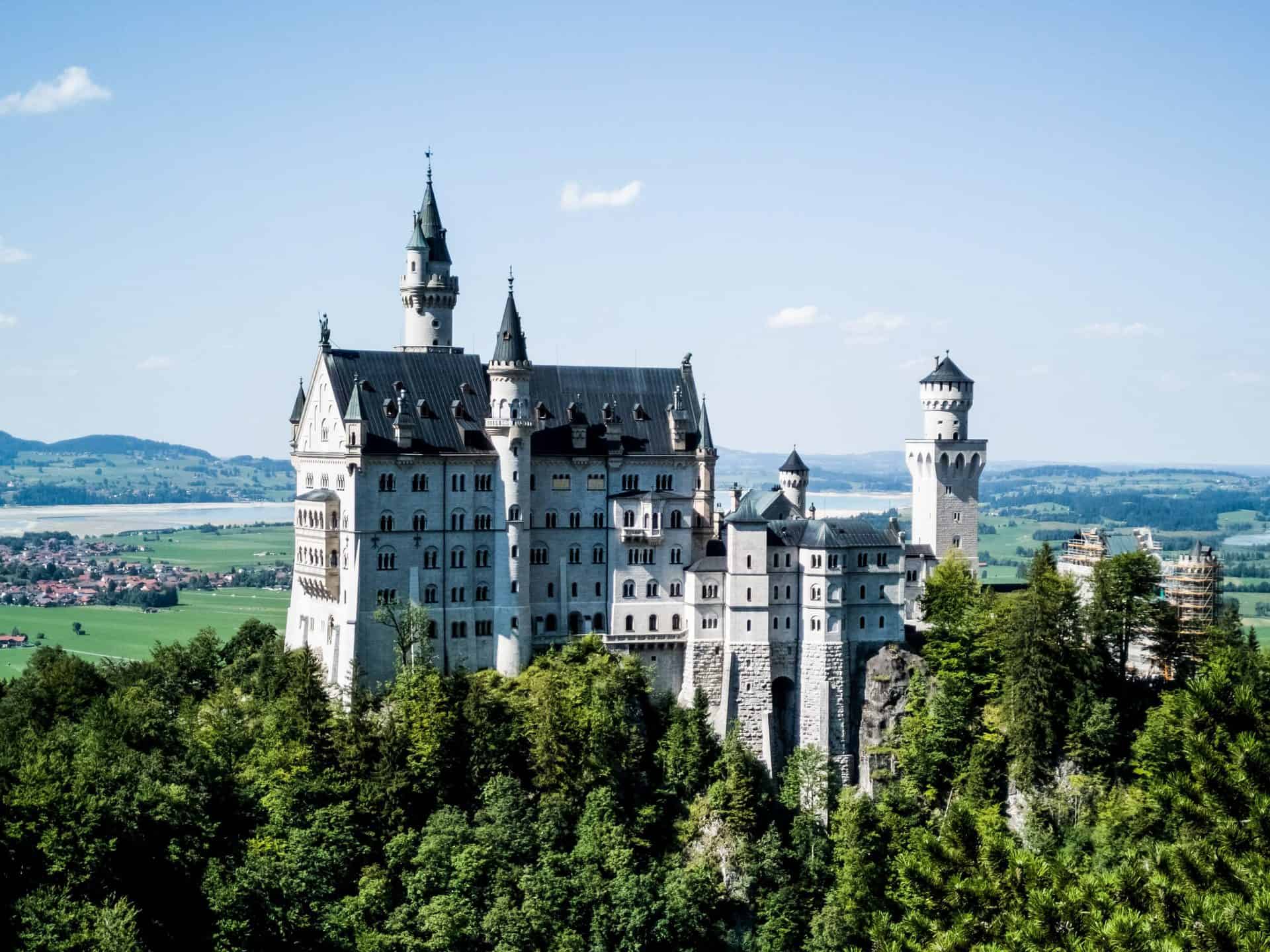
Updated On: November 07, 2023 by Ciaran Connolly
Medieval castles in Europe carry a certain charm and mystique that cannot be found anywhere else, especially if these medieval castles were built in a different time. However, they are often shrouded in mystery and legend, perhaps because many historical facts are distorted as time goes by. That certainly explains why there are so many legends and myths surrounding the history of the Neuschwanstein Castle, one of the most popular castles in Europe, attracting 1.5 million visitors a year.
Known as the ‘castle of the fairy tale king’, construction on Neuschwanstein Castle began in 1869 in Bavaria, Germany as commissioned by King Ludwig II of Bavaria. The castle’s design is so unique that it is said to have inspired Walt Disney to build the Disney Castle.

King Ludwig II of Bavaria was also known as the Swan King or the Fairy Tale King, probably due to the romantic design of the castle, which is very reminiscent of many fairy tale castles from folklore. Inside the castle, the walls are covered with paintings depicting medieval legends, adding to its romantic atmosphere.
As he was growing up, it seemed that Ludwig enjoyed dreaming about the world of legends, knights, and fair maidens, rather than living in the real world.
When his father Maximilian II died suddenly in 1864, Ludwig reluctantly ascended to the throne. He was so overwhelmed by this change of fate that came much earlier than he expected, that three days later he wrote one word in his diary, filling the entire page: ‘King’.
Since his father had made him keep specific accounts of the exact amounts of money he spent, Ludwig, now King Ludwig, decided that he would now spend as much money as he deemed necessary, attempting to erase what his father had taught him. Of course, his overindulgence and spendthrift habits did not go well with the people of the capital, but it was a different story in Bavaria.
King Ludwig rarely made public appearances, which seemed to create opportunities for a lot of stories to circulate about what he was really like. However, most of these stories seemed to paint him in a favorable light, at least in the countryside, where he was said to ride his horse across the fields and distribute expensive gifts to some of the subjects he encountered along the way.
He decided to sponsor Wagner, whose operas were heavily inspired by the medieval world, which naturally made King Ludwig an ardent fan of his music. He even informed Wagner of his plans to build a new castle reminiscent of the castles built for ancient German knights.
Neuschwanstein Castle
King Ludwig commissioned the painter Christian Jank to do the initial sketches of the castle, mixing between elements from medieval Germany, Moorish Spain, and the world of Wagner’s works. It seemed he was looking for a way to escape reality altogether. The castle was indeed built for a reclusive king, as it is said that the dining room table had enough space for one person.
He worked meticulously on every aspect of the construction, wanting it to be just as he had envisioned. The castle was built with bricks and then covered with rocks from a nearby quarry. The cliff face and the walls are made up of the same materials. The construction of the castle was quite sophisticated for its time.
The castle quickly became everything King Ludwig had wanted and more. The Throne Room is reminiscent of medieval throne rooms, with murals of legends and fairy tales covering the walls. Despite the existence of the throne room, it contained no throne and no audiences were held there for his subjects or courtiers.
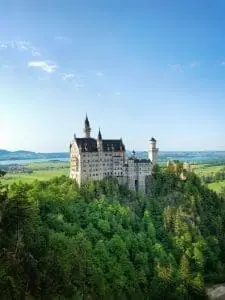
The columns in the throne room are made of stucco marble stuck onto cast-iron columns. The castle presents a perfect mix of the latest technologies of its time intermingled with medieval aesthetics.
The dome of the throne room is a self-supporting construction, a technique that was innovative technique at the time.
The castle had boiler rooms that fed the castle with warm air, as a cutting-edge heating mechanism, proving his preference for luxury even amidst the middle ages design.
Among the other modern conveniences installed in the castle were the water closet, battery-operated bells, warm air heating, and a telephone, even though at the time few people had telephones. Additionally, the dining room was serviced by an elevator from the kitchen three stories below.
The bedchamber of King Ludwig II featured the tragic love story of Tristan and Isolde on its walls. He made sure to add religious elements to the interior design as well. His washbasin resembled a baptismal font, and even the cup for his toothbrush resembled a communion chalice. He also ordered chandeliers with nickel plating and expensive furniture and sculptures.
During construction, King Ludwig was known to show up and hand out cigars to the craftsmen whose work he admired, which was standard practice at the time. Neuschwanstein cost around 6 million Marks (equivalent to 42 million Euros today).
A Castle for One Man
No guest rooms, a throne room without a throne, and a dining room for one. Ludwig’s design for the castle was an attempt to transform a mythological and dream-like world into architectural reality. He wanted to bring all his fairytale fantasies to life in one way or another, to create a world that he could inhabit on his own, away from anything that could interfere with his preference for solitude.
A stalactite grotto located in the middle of the castle leads to a secret doorway behind which is the servant’s stairway, hidden away from view. He wanted the servants to be able to do their work quickly but in a way that would still maintain his solitary state.
Although it was rumored that King Ludwig bankrupted the royal treasury to build his castles but that is simply a rumor. In reality, he received an annual sum of money which he used for his ambitious construction projects. Still, his ministers asked him to limit the immense amount of his projects when he took loans from foreign banks to complete his projects, to which he replied, “I can’t. Building is my greatest joy in life.”
He even planned to build a fortified 90-meter tower rising above the castle with a chapel on the ground floor and a keep right above it. The tower’s design was inspired by a set design for Wagner’s opera Lohengrin. However, it wasn’t meant to be.
The craftsmen who worked on the castle had begun filing suits against the King because they hadn’t been paid their proper wages. King Ludwig incurred a debt equivalent to 100 million Euros.
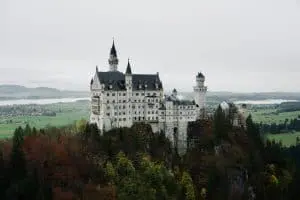
The Curse of Neuschwanstein Castle
In 1875, Mr. Herold, the foreman at the King’s castle who had laid the foundation of the construction in 1869, suffered a mental breakdown and took his own life. The incident was so shocking that it became known as ‘The Curse of Neuschwanstein’.
This wasn’t the only tragedy that befell the castle.
With all the debts he accumulated for his extravagant building projects, King Ludwig gained a reputation as Mad King Ludwig. No one understood why he enjoyed spending time alone or exploring nature rather than ruling, which had even been a huge disappointment to his father when he was alive. But even more so, no one understood the purpose of his excessive spending on building castles.
Neuschwanstein Castle was seen by many as overly extravagant, and that his focus on his architectural projects took him away from his actual duties. While today opinions on his mental state differ, from suggesting he had early signs of dementia to neurological diseases, at the time his ministers were impatient and angered by his actions.
In 1886, a government commission had arrived from Munich to remove him from power on the basis of mental illness, but still unable to accept his fate, he took the men into custody. Two days later, he finally submitted and they took him to Berg Castle on Lake Starnberg, where he was placed under house arrest.
What followed has confused and bewildered people for years.

Shortly after he was imprisoned, King Ludwig II, now 40 years of age, drowned in Lake Starnberg under mysterious circumstances. What has baffled many since then is the fact that the psychiatrist who had certified him insane drowned with him. What confused many people was that the King was a very good swimmer, so he could not have accidentally drowned. Many were also reluctant to accept that he might have given up on life after the shock of imprisonment.
This released a bevy of conspiracy theories, one of which suggested that the King was alive and had withdrawn to a mountain hut to live out the rest of his days alone and that the body in his coffin was simply a wax figure.
Another theory suggested that King Ludwig had killed his psychiatrist as there were marks of struggle on the doctor’s body, and afterward, Ludwig had been so shocked at what he had done that he had committed suicide, or he may have drowned accidentally amidst the struggle.
Even his funeral was surrounded by mystery, as it is said that, shortly after Ludwig’s coffin arrived, a severe storm passed through. The storm was so strong that a flash of lightning slashed through, throwing several people up against the church wall.
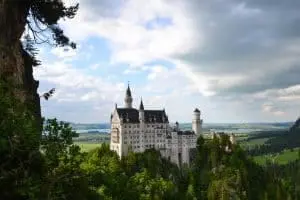
Around fifty years ago, a distant relative of the Royal family, Countess Josephine von Wrba-Kaunitz, held a tea party, during which she revealed to her guests proof that King Ludwig II was murdered; a grey jacket with a bullet-hole, which she claimed to have belonged to the late King. Sadly, this piece of evidence was lost in a house fire a few years later.
King Ludwig II had lived at Neuschwanstein Castle for less than a year before his untimely imprisonment and death. He never even got to see the castle after it was finished since some sections are still incomplete to this day. He used to stay in the Gateway Building when he’d visit to oversee the progress.
A few weeks after King Ludwig II’s death, the castle was opened to visitors, drawing quite a lot of attention as a lot of people wanted to see the home of the mad king.
Over the years, the castle received many well-known figures, such as former First Lady of America Barbara Bush, the Queen of Thailand, and former Soviet President Mikhail Gorbachev
Wars and Restorations
During World War II, the castle remained unscathed, but due to its isolated location and the fact that it was uninhabited, it was used to house looted artworks from France. When the American troops arrived they found around 600 crates or sculptures, statues, and paintings that were eventually salvaged and returned to France after the war.
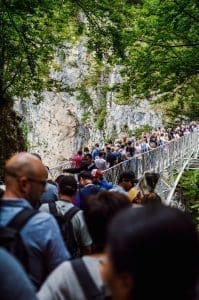
The castle underwent many restorations over the years, which presented quite the challenge due to its difficult location. Although painters are currently working on restoring the murals and paintings in the Singer’s Hall of the castle, it is quite remarkable that they are still in great shape in spite of their exposed position for all of these years, which indicates the expert craftsmanship of those who worked on the original designs.
Guided Tours and Visits
To this day, this fairy tale castle continues to enchant visitors and tourists from all over the world with its breathtaking location and fascinating architecture mixing between two worlds.
The palace can only be visited during 35-minute guided tours, and no photography is allowed inside to preserve the interior as much as possible. If you’re visiting during peak season, i.e from June until August when Neuschwanstein has as many as 6,000 visitors per day, be sure to get there early and reserve your tickets in advance so as to avoid the long waiting lines that can last for hours.
If you wish to visit the castle without a ticket, you can enter the grounds and courtyard, but not the interior of the castle. The castle is open throughout the year and during most public holidays, but be sure to check in advance, just in case.
Opening hours from mid-March to mid-October are from 9:00 am to 6:00 pm and from mid-October to mid-March are from 10:00 am to 4:00 pm.






